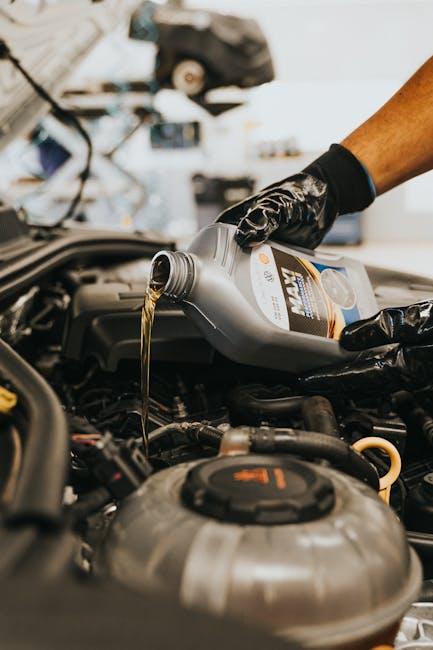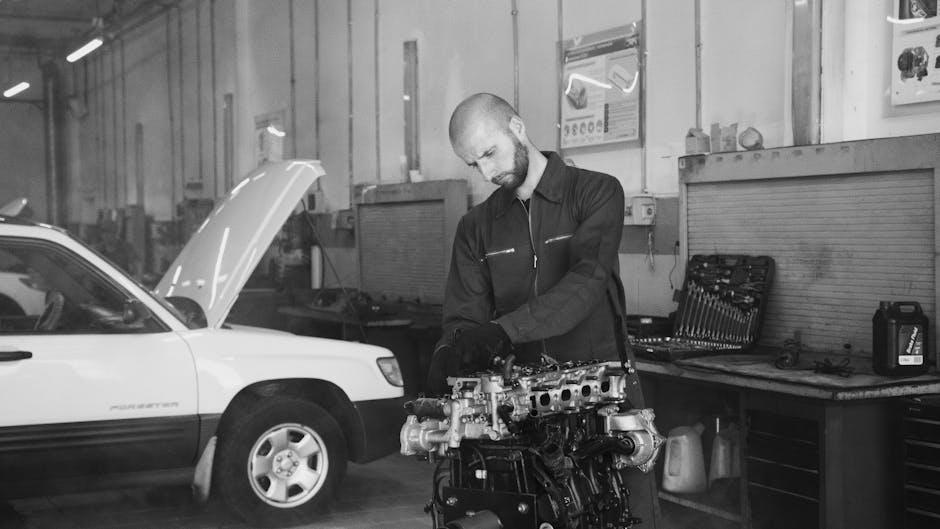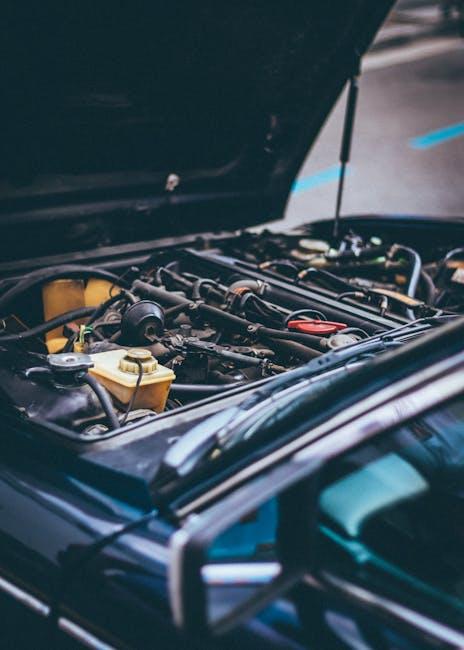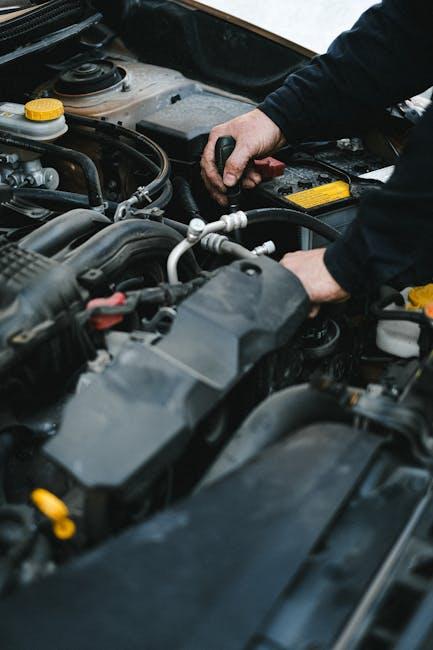Beneath the sleek exterior and roaring power of every vehicle lies an engine—a complex heart that drives your journey forward. Just like any finely tuned instrument, it requires regular care to perform at its best. But how often should you service this mechanical powerhouse? Striking the right balance between neglect and over-maintenance can unlock longevity, efficiency, and peace of mind on the road. In this article, we delve into the factors that influence engine servicing intervals and explore practical guidelines to help you keep your engine running smoothly for miles to come.
Table of Contents
- Understanding the Importance of Regular Engine Maintenance
- Recognizing Key Signs Your Engine Needs Servicing
- Manufacturer Guidelines Versus Real-World Usage Patterns
- The Role of Driving Conditions in Service Frequency
- Choosing Between Routine Tune-Ups and Comprehensive Overhauls
- Balancing Cost and Long-Term Engine Health Through Scheduled Care
- Q&A
- In Conclusion

Understanding the Importance of Regular Engine Maintenance
Every engine is a masterpiece of engineering, but like any finely tuned mechanism, it requires consistent care to perform at its best. Neglecting regular engine maintenance can lead to decreased fuel efficiency, unexpected breakdowns, and costly repairs down the road. By sticking to a routine service schedule, you not only extend the life of your engine but also ensure that your vehicle runs smoothly, safely, and with optimal power output.
Key components targeted during regular servicing include oil and filter changes, spark plug inspection, and air filter replacements. Maintenance also involves checking belts, hoses, and fluids to prevent wear that could compromise engine health. Below is a quick breakdown of essential checks typically included in a service appointment:
- Oil and filter replacement: Keeps internal parts lubricated and cleans out impurities.
- Spark plugs: Ensure efficient combustion for smooth starts.
- Air filter: Maintains clean airflow to improve fuel efficiency.
- Fluid levels: Includes coolant, brake, and transmission fluids for overall vehicle health.
| Service Interval | Common Tasks | Impact |
|---|---|---|
| Every 5,000 – 7,500 miles | Oil change, tire rotation | Superior lubrication, extended tire life |
| Every 15,000 – 30,000 miles | Air filter, spark plugs check | Improved fuel economy, better engine performance |
| Every 50,000 – 60,000 miles | Fluid flush, belt & hose inspection | Prevents overheating and mechanical failures |

Recognizing Key Signs Your Engine Needs Servicing
Spotting early indications that your engine demands attention can save you from unexpected breakdowns and costly repairs. Pay close attention to unusual noises such as knocking, ticking, or grinding sounds when starting or running the engine. These can signal wear or failing components. Another critical symptom is frequent stalling or rough idling, which hints at fuel or ignition system issues. Watch for excessive smoke from the exhaust, which might point to oil leaks or inefficient combustion. Don’t overlook dashboard alerts either; a glowing check engine light is a clear prompt to act swiftly.
Beyond these audible and visual signals, there are subtler signs worth noting. A noticeable drop in fuel efficiency often suggests your engine is struggling or needs servicing. Vibrations or reduced power during acceleration can indicate underlying problems that demand professional diagnostics. Consider this quick reference table for typical signs and possible causes:
| Symptom | Possible Cause | Recommended Action |
|---|---|---|
| Knocking noises | Worn piston rings or bearings | Immediate inspection |
| Check engine light on | Sensor or emission issues | Use diagnostic scan |
| Excessive exhaust smoke | Oil leaks or incomplete combustion | Check engine seals, tune-up |
| Reduced fuel economy | Fuel system inefficiency | Fuel filter and injector check |

Manufacturer Guidelines Versus Real-World Usage Patterns
Manufacturers provide engine service intervals based on controlled testing environments, ideal driving conditions, and optimal fuel quality. These recommendations—often found in your vehicle’s owner manual—reflect a one-size-fits-all approach that ensures the engine operates smoothly within standard parameters. Typically, these guidelines suggest oil changes every 5,000 to 10,000 miles, alongside periodic checks of filters, belts, and fluids. Following these intervals helps maintain warranty coverage and supports the engine’s longevity under “normal” operating conditions.
However, real-world usage often tells a different story. Variables such as frequent short trips, extreme weather, dusty or urban environments, and aggressive driving can accelerate wear and tear, demanding more frequent attention than factory schedules suggest. For instance:
- City commuters, who encounter stop-and-go traffic, may need oil changes more regularly.
- Off-road enthusiasts should monitor air filters and suspension components closely.
- Highway drivers often benefit from longer service intervals but should still adhere to other maintenance checks.
| Driving Condition | Recommended Oil Change Frequency | Additional Notes |
|---|---|---|
| Urban Stop-and-Go | Every 3,000-5,000 miles | Frequent idling increases engine strain |
| Highway Cruising | Every 7,500-10,000 miles | Consistent speeds reduce engine wear |
| Off-Road/Dusty | Every 4,000-6,000 miles | Air filter checks critical |

The Role of Driving Conditions in Service Frequency
Service intervals are not one-size-fits-all; the conditions you drive under dramatically shape how often your engine needs attention. For example, frequent stop-and-go city traffic, harsh weather conditions like extreme cold or intense heat, and dusty or unpaved roads all place additional strain on engine components. These factors accelerate wear and tear, meaning your engine might require more frequent checks to maintain optimal performance and avoid costly repairs.
Understanding your daily driving environment can help tailor your service schedule more effectively. Consider these common scenarios that impact service frequency:
- Urban commutes: Increased idling and frequent stops lead to faster oil degradation.
- Long highway drives: Generally less stressful but require attention to fluid levels and tire condition.
- Off-road or rural driving: Higher exposure to dust and debris demands more frequent air filter and engine inspections.
- Extreme climates: Both high and low temperatures can affect engine oil viscosity and battery life.
| Driving Condition | Recommended Service Check | Typical Interval Adjustment |
|---|---|---|
| City traffic | Oil change and brake inspection | Every 5,000 miles |
| Highway cruising | Fluid levels and tire rotation | Every 7,500 miles |
| Off-road use | Air filter and suspension check | Every 4,000 miles |
| Extreme temperatures | Battery and coolant system | Every 5,000 miles |

Choosing Between Routine Tune-Ups and Comprehensive Overhauls
Deciding between a routine tune-up and a comprehensive overhaul often depends on the age, mileage, and current condition of your engine. Routine tune-ups are designed to keep your engine running smoothly and efficiently by addressing common maintenance tasks such as replacing spark plugs, changing filters, and checking fluid levels. These quick fixes enhance performance, improve fuel economy, and extend the life of your engine when performed regularly. They’re ideal for vehicles with moderate mileage or those showing minor performance issues.
On the other hand, comprehensive overhauls dive deeper into the engine’s internal components, often required for high-mileage or extensively worn-out engines. This process may involve replacing pistons, valves, or rebuilding the cylinder head, effectively restoring the engine to near-new condition. Choosing the right service ensures cost efficiency and reliability, as skipping an overhaul when necessary can lead to bigger problems down the road. Consider the following to guide your decision:
- Routine Tune-Up: Preventative care, lower cost, frequent intervals
- Comprehensive Overhaul: Repair major wear, higher cost, infrequent but vital
| Service Type | When to Choose | Typical Cost Range |
|---|---|---|
| Routine Tune-Up | Every 10,000-30,000 miles or minor engine issues | $100 – $300 |
| Comprehensive Overhaul | Over 100,000 miles or severe performance problems | $1,500 – $4,000 |

Balancing Cost and Long-Term Engine Health Through Scheduled Care
Finding the sweet spot between the expenses of frequent servicing and the long-term vitality of your engine requires a strategic approach. Regular maintenance might seem costly upfront, but it often saves money by preventing major repairs down the line. It’s about *investing intelligently*: catching wear and tear early enhances performance and extends engine life. Factors influencing your schedule include driving habits, environmental conditions, and your vehicle’s make and model. Tailoring the service timeline allows you to optimize spend without compromising on engine care.
Consider the following routine actions to balance cost and engine health:
- Oil and filter changes: Keeps the engine lubricated and running smoothly.
- Coolant checks: Prevents overheating and corrosion.
- Air filter replacements: Ensures efficient fuel combustion.
- Timing belt inspections: Avoids catastrophic engine damage.
| Service Type | Recommended Frequency | Cost Efficiency |
|---|---|---|
| Oil Change | Every 5,000 – 7,500 miles | High |
| Air Filter | Every 15,000 – 30,000 miles | Moderate |
| Timing Belt | Every 60,000 – 100,000 miles | Critical |
Q&A
Q: How often should you service your engine?
A: Generally, it’s recommended to service your engine every 5,000 to 7,500 miles, or roughly every 6 months. However, this can vary depending on your vehicle’s make, model, and driving conditions.
Q: Why can’t I just wait until something feels wrong with my engine?
A: Waiting for trouble to appear often leads to bigger, costlier repairs. Regular servicing helps catch small issues early, ensuring your engine runs smoothly and efficiently.
Q: Does the type of oil I use affect how often I need to service my engine?
A: Yes! Synthetic oils tend to last longer and perform better under extreme conditions, potentially stretching the interval between oil changes. Your car’s manual will guide you on the best oil type and service frequency.
Q: What factors might make me need to service my engine more often?
A: Driving habits like stop-and-go city traffic, towing heavy loads, dusty environments, and extreme temperatures all put extra strain on your engine, meaning more frequent servicing may be necessary.
Q: Can technology in modern cars extend service intervals?
A: Absolutely. Many modern vehicles come with onboard diagnostics and oil-life monitoring systems that alert you when service is truly needed, helping to optimize maintenance schedules.
Q: Besides oil changes, what else is typically included in an engine service?
A: A thorough service often includes checking and replacing air filters, inspecting belts and hoses, topping off fluids, and examining spark plugs and the battery to keep your engine in prime condition.
Q: What’s the risk of ignoring regular engine servicing?
A: Neglecting service can lead to decreased fuel efficiency, increased emissions, poor engine performance, and even major mechanical failures that are expensive to fix.
Q: Can I service my engine myself, or should I go to a professional?
A: Basic maintenance like checking oil levels can be done at home, but comprehensive engine servicing requires knowledge and specialized tools best handled by professionals to ensure everything is done correctly.
Q: How do I find the specific service schedule for my vehicle?
A: Your vehicle’s owner manual is the best place to start. Manufacturers tailor service intervals based on their engine design and testing, providing the most accurate guidance for your car.
Q: Overall, what’s the best mindset to have about engine servicing?
A: Think of engine servicing as an investment in your vehicle’s longevity. Regular care helps prevent breakdowns, saves money in the long run, and keeps your driving experience smooth and safe.
In Conclusion
In the end, there’s no one-size-fits-all answer to how often you should service your engine—because each vehicle, driving style, and environment paints a different picture. Think of engine maintenance as a conversation rather than a chore: listening to your car’s needs, consulting the manual, and checking in with trusted mechanics will keep the dialogue flowing smoothly. Regular service isn’t just about ticking off a checklist; it’s about nurturing the heart of your vehicle so it can carry you forward without a hitch. So, as you hit the road, remember that timely engine care is the quiet hero behind every reliable journey.


2 Comments
xz37zx
xz37zx